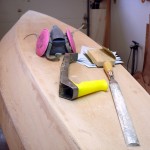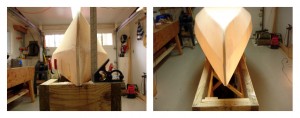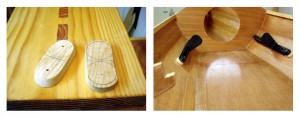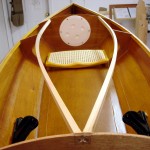(3rd of 3 postings today) When our children were young, my wife volunteered to help with food preparation for some school event which included an evening meal. She called a food distributor to explain her task and ask how many servings are in a gallon can of baked beans. The woman on the other end of the line answered, “Oh honey, that won’t be nearly enough.”
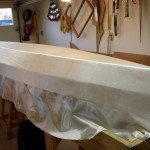 The instructions for the Mill Creek 13 are a little bit like that. … But, I’m getting ahead of things.
The instructions for the Mill Creek 13 are a little bit like that. … But, I’m getting ahead of things.
This boat is covered with fiberglass fabric that is adhered with epoxy. After making the hull suitably smooth, the fabric is draped on the hull, smoothed, and trimmed. The weave of the fabric is loose enough that it complies very easily to the shape of the hull. I was expecting ripples and pleats, but was very pleasantly surprised to see the fabric fit neatly. After draping, the instructions call for trimming the fabric to within 1/4 inch of the edges of the hull. Right! The experienced stitch-n-glue builders probably work to that tolerance, but I’m apprehensive about making a trimming error. I got to within 1/2 inch on average.
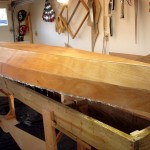 OK, back to baked bean servings and epoxy mixing instructions. The intent of this stage of work is to “wet out” the cloth. That is, apply enough epoxy to wet the cloth, make it turn from white to transparent, enough to make it adhere, but not so much as to flood it, create runs and puddles. So … the instructions say to mix up 8 ounces of epoxy (that’s a cup for you folks who cook), and I’m thinking “Oh honey, that won’t be nearly enough.”
OK, back to baked bean servings and epoxy mixing instructions. The intent of this stage of work is to “wet out” the cloth. That is, apply enough epoxy to wet the cloth, make it turn from white to transparent, enough to make it adhere, but not so much as to flood it, create runs and puddles. So … the instructions say to mix up 8 ounces of epoxy (that’s a cup for you folks who cook), and I’m thinking “Oh honey, that won’t be nearly enough.”
There is actually a very good reason for that mixing suggestion. A cup is about the right amount for the working time needed to spread, smooth, re-spread, squeegee off, the epoxy. Any more than a cup and it will start thickening before it’s all spread. In the end, it took me about 2 1/2 cups. Whether that’s the right amount, I don’t know. Yet, there’s fiberglass stuck to the boat, no runs, and it looks like it was done by someone who knew what they were doing.
Oh yeah … spread drop cloths (trash bags in my case) on the floor under the edges of the boat before your (gloved) epoxy soaked hands get too sticky to handle the drop cloths. (Don’t ask how I came up with this tip.)
Oh yeah … (once more) the reason for trimming to 1/4 inch is to minimize wagging interference from the cloth hanging at the bottom, but more importantly to minimize the amount of epoxy it can absorb.
